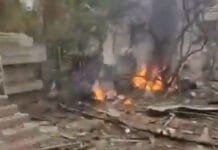In a significant escalation of tensions in the Middle East, Israel’s Defense Forces (IDF) have issued a direct warning to residents of southern Lebanon. The Iran-backed Hezbollah militant group has long used this region as a base to store weapons and stage operations, and the IDF’s recent advisory signals Israel’s growing intention to eliminate Hezbollah’s military capabilities. With the IDF asking civilians to vacate their homes immediately, the message is clear: Israel is preparing for an aggressive military campaign that could drastically alter the region’s security landscape.
Israel’s Bold Move Against Hezbollah
The warning issued by IDF spokesman Rear Admiral Daniel Hagari to the people of Lebanon is the latest in a series of developments that highlight Israel’s determination to neutralize Hezbollah’s presence in southern Lebanon. As a terrorist organization recognized by numerous countries, including the United States and the European Union, Hezbollah has entrenched itself in Lebanese villages, often storing weapons and building hidden military infrastructure amid civilian populations. This tactic has placed thousands of Lebanese civilians in the crossfire, making the IDF’s warning all the more urgent.
The Scope of Hezbollah’s Retaliatory Strikes
In the wake of escalating conflict, Hezbollah has responded to Israeli military actions by launching a barrage of over 100 rockets, missiles, and drones targeting northern Israel. The attacks were framed as retaliation after Israeli forces killed one of Hezbollah’s top commanders and several fighters. This exchange of hostilities has ignited fears of a broader war, particularly as Israel remains engaged in its ongoing battle with Hamas in the Gaza Strip.
With Hezbollah’s ability to strike deep into Israeli territory, the conflict’s scope could widen, threatening not only the immediate regions along the Israel-Lebanon border but also impacting international stability. The proximity of Hezbollah’s rocket launchers to civilian areas is a deliberate tactic, designed to complicate Israeli military responses, and raise the potential for civilian casualties on both sides.
IDF’s Strategic Communication: A Warning to Lebanese Civilians
The IDF has communicated directly with the Lebanese population, writing messages in Arabic urging civilians to leave villages that house Hezbollah’s weapon stockpiles. The specific wording of the message leaves no ambiguity: if you are in a building where Hezbollah stores its weapons, it is imperative to evacuate until further notice. This represents a stark warning that the IDF’s military operations could begin imminently, targeting the very places where Hezbollah hides its arsenal.
The intensity of these warnings demonstrates Israel’s intention to avoid civilian casualties wherever possible, while also underlining the IDF’s resolve to dismantle Hezbollah’s infrastructure. However, it remains unclear how many Lebanese civilians will be affected by these orders, as the area has already seen significant evacuations due to daily cross-border shelling and military activity.
Civilian Displacement: A Growing Humanitarian Crisis
As conflict intensifies, entire communities on both sides of the Israel-Lebanon border have been forced to evacuate. Daily shelling, along with air raids and ground operations, has pushed families to leave their homes, adding to the growing humanitarian crisis. In southern Lebanon, where Hezbollah has transformed rural areas into terrorist strongholds, civilians are caught between Hezbollah’s militarization and Israel’s decisive strikes.
Israel has long accused Hezbollah of turning civilian infrastructure into military bases, using homes, schools, and even hospitals to store weapons and launch attacks. This tactic makes it increasingly difficult for the IDF to conduct surgical strikes without risking civilian lives, contributing to the urgency of the IDF’s public warnings.
The Broader Context: A Conflict on Multiple Fronts
While the Israel-Hezbollah tensions rise, Israel is already engaged in a fierce battle against Hamas in Gaza. Since the deadly October 7 attack by Hamas, in which numerous Israelis were killed and several hostages were taken, Israel has ramped up its military activities in the region. The IDF has been working relentlessly to dismantle Hamas’s capabilities, but this multi-front conflict poses significant strategic challenges for the Israeli military.
Escalating Hostilities: Potential for a Larger War
The prospect of an all-out war between Israel and Hezbollah is a concern not just for the region but for the international community. Hezbollah is significantly more militarized than Hamas, with thousands of fighters, advanced weaponry, and backing from Iran, making any conflict with the group potentially far more destructive. Hezbollah’s rocket and missile arsenal is larger and more sophisticated, capable of reaching deeper into Israeli territory than Hamas’s armaments.
Additionally, Hezbollah’s involvement could open the door to Iranian influence, further complicating the conflict and drawing in other regional powers. The geopolitical implications of such a confrontation could destabilize the entire Middle East, with repercussions felt globally in terms of energy markets, international relations, and security concerns.
Israel’s Military Strategy: Targeting Hezbollah’s Strongholds
The IDF’s strategy against Hezbollah is clearly focused on targeting key military assets, including weapons caches, rocket launchers, and militant command centers. These are often hidden within civilian areas, making Israel’s military campaign both dangerous and delicate. Striking a balance between eliminating Hezbollah’s military capabilities and minimizing civilian casualties is one of the most difficult challenges the IDF faces.
Recent reports indicate that Hezbollah has embedded its weapons infrastructure deep within the southern Lebanese countryside, transforming entire villages into operational bases. This has not only made these areas targets for Israeli strikes but has also placed civilians in the line of fire. Israel has repeatedly called out Hezbollah for its use of human shields, a practice that violates international humanitarian law and exacerbates the conflict’s human cost.
Hezbollah’s Response: Testing Israel’s Resolve
In response to Israel’s heightened military actions, Hezbollah has made it clear that it will not back down. The group’s leader, Hassan Nasrallah, has publicly stated that Hezbollah will continue to retaliate against Israeli strikes and that they are prepared for a prolonged conflict. Hezbollah’s ability to mobilize thousands of fighters and deploy advanced weaponry means that any military engagement with Israel will be protracted and fierce.
However, Israel’s growing commitment to eliminating Hezbollah’s influence in southern Lebanon is evident in its recent military actions. By targeting Hezbollah’s command structure and weapons stockpiles, Israel is sending a strong message: it is prepared to confront Hezbollah head-on, regardless of the risks.
The Future: Is a Ceasefire Possible?
As tensions escalate and the potential for a broader war looms, the international community is calling for restraint. However, given the deeply entrenched positions on both sides, a ceasefire seems unlikely in the near term. Hezbollah’s continued attacks, coupled with Israel’s determination to secure its northern border and eliminate Hezbollah’s military threat, point to a prolonged conflict with potentially devastating consequences for the region.
Israel’s strategic military moves suggest that it is unwilling to allow Hezbollah to maintain its presence in southern Lebanon. Whether this results in a full-scale war or a prolonged series of skirmishes remains to be seen. What is certain is that the region is on the brink of a significant military confrontation, with the potential to reshape the Middle East’s geopolitical landscape for years to come.
















